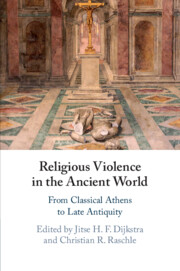Book contents
- Religious Violence in the Ancient World
- Religious Violence in the Ancient World
- Copyright page
- Contents
- Acknowledgements
- List of Contributors
- A Note on Abbreviations
- General Introduction
- Part I Methodology
- Part II Religious Violence in the Graeco-Roman World
- Chapter 3 Ancient Greek Binding Spells and (Political) Violence
- Chapter 4 The Expulsion of Isis Worshippers and Astrologers from Rome in the Late Republic and Early Empire
- Chapter 5 Religious Violence? Two Massacres on a Sabbath in 66 ce: Jerusalem and Caesarea
- Chapter 6 Religion, Violence and the Diasporic Experience: The Jewish Diaspora in Flavian Rome and Puteoli
- Chapter 7 Animal Sacrifice and the Roman Persecution of Christians (Second to Third Century)
- Chapter 8 The Great Persecution and Imperial Ideology: Patterns of Communication on Tetrarchic Coinage
- Chapter 9 The Violent Legacy of Constantine’s Militant Piety
- Part III Religious Violence in Late Antiquity
- Index of Sources
- General Index
Chapter 4 - The Expulsion of Isis Worshippers and Astrologers from Rome in the Late Republic and Early Empire
from Part II - Religious Violence in the Graeco-Roman World
Published online by Cambridge University Press: 18 September 2020
- Religious Violence in the Ancient World
- Religious Violence in the Ancient World
- Copyright page
- Contents
- Acknowledgements
- List of Contributors
- A Note on Abbreviations
- General Introduction
- Part I Methodology
- Part II Religious Violence in the Graeco-Roman World
- Chapter 3 Ancient Greek Binding Spells and (Political) Violence
- Chapter 4 The Expulsion of Isis Worshippers and Astrologers from Rome in the Late Republic and Early Empire
- Chapter 5 Religious Violence? Two Massacres on a Sabbath in 66 ce: Jerusalem and Caesarea
- Chapter 6 Religion, Violence and the Diasporic Experience: The Jewish Diaspora in Flavian Rome and Puteoli
- Chapter 7 Animal Sacrifice and the Roman Persecution of Christians (Second to Third Century)
- Chapter 8 The Great Persecution and Imperial Ideology: Patterns of Communication on Tetrarchic Coinage
- Chapter 9 The Violent Legacy of Constantine’s Militant Piety
- Part III Religious Violence in Late Antiquity
- Index of Sources
- General Index
Summary
Recent debates on religious violence in the Roman empire have focused mainly on the change from a polytheistic to a monotheistic empire, ‘das Problem des Monotheismus’, as stated by the Egyptologist Jan Assmann.1 In the tradition of the Enlightenment, polytheism and traditional religious practices are depicted as tolerant, because their inclusive character allowed individuals to adhere freely to as many and whichever cults they desired.2 The associated belief-systems are generally considered to have been open and non-coercive. Even the very category of ‘belief’ has been called into question, since it was the adequate performance of the rites that mattered. New cults could always be adapted and reinterpreted in familiar terms.3 Since gods and spirits were conceived of mainly as local entities, the veneration of foreign gods and spirits in a foreign country would be nothing more than a polite act: when in Alexandria, do as the Alexandrians do. Finally, nothing prevented an individual with enough backers and financial means from founding his or her own shrine.
- Type
- Chapter
- Information
- Religious Violence in the Ancient WorldFrom Classical Athens to Late Antiquity, pp. 87 - 105Publisher: Cambridge University PressPrint publication year: 2020

